Regional-Scale Paleoproterozoic Heating Event on Archean Acasta Gneisses in Slave Province, Canada: Insights from K–Ar and 40Ar/39Ar Chronology
Abstract
:1. Introduction
2. Geological Setting
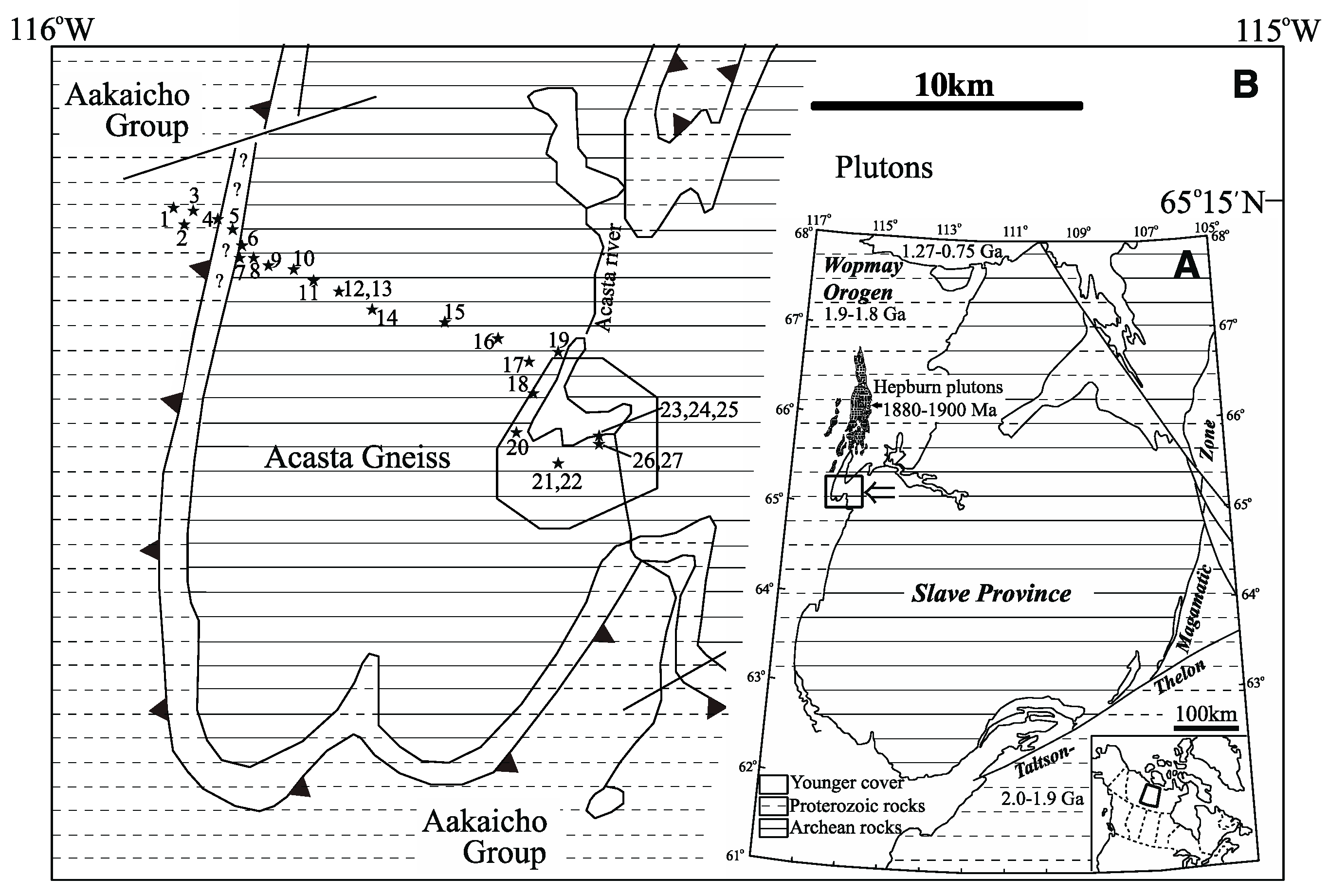
3. Samples and Chemistry of Biotite and Amphibole
4. K–Ar Analyses
5. Laser Step-Heating 40Ar/39Ar Analyses
6. Discussion
6.1. Wopmay Orogen Event on Archean Acasta Gneiss Complex
6.2. Paleoproterozoic Hepburn Batholith
6.3. Heat Source Affecting the Acasta Gneiss
7. Summary
Supplementary Materials
Author Contributions
Funding
Data Availability Statement
Acknowledgments
Conflicts of Interest
Appendix A. Compositional Dependence on Closure Temperature

Appendix B. Excess Argon Wave
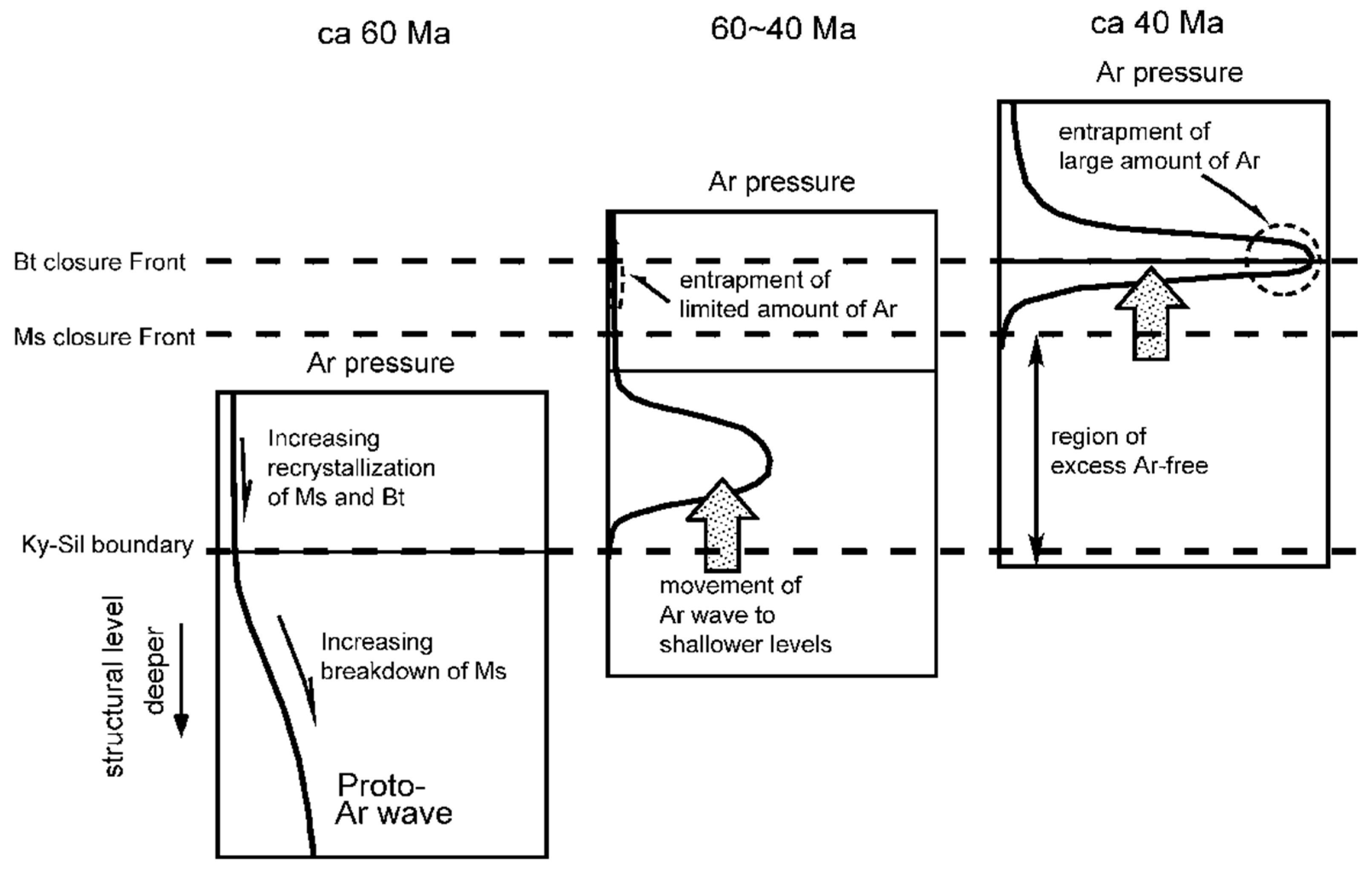
References
- Hoffman, P.F. Precambrian geology and tectonic history of North America. In The Geology of North America: An Overview; Bally, A.W., Palmer, A.R., Eds.; Geological Society of America, Geology of North America: Boulder, CO, USA, 1989; pp. 447–512. [Google Scholar]
- Bowring, S.A.; Grotzinger, J.P. Implications of new chronostratigraphy for tectonic evolution of Wopmay orogen, northwest Canadian Shield. Am. J. Sci. 1992, 292, 1–20. [Google Scholar] [CrossRef]
- Bowring, S.A.; Williams, I.S.; Compston, W. 3.96 Ga gneisses from the Slave province, Northwest Territories, Canada. Geology 1989, 17, 971–975. [Google Scholar] [CrossRef]
- Iizuka, T.; Horie, K.; Komiya, T.; Maruyama, S.; Hirata, T.; Hidaka, H.; Windley, B.F. 4.2 Ga zircon xenocryst in an Acasta gneiss from northwestern Canada: Evidence for early continental crust. Geology 2006, 34, 245–248. [Google Scholar] [CrossRef]
- Iizuka, T.; Komiya, T.; Ueno, Y.; Katayama, I.; Uehara, Y.; Maruyama, S.; Hirata, T.; Johnson, S.P.; Dunkley, D.J. Geology and zircon geochronology of the Acasta Gneiss Complex, northwestern Canada: New constraints on its tectonothermal history. Precanbrian Res. 2007, 153, 179–208. [Google Scholar] [CrossRef]
- Guitreau, M.; Mora, N.; Paquette, J.-L. Crystallization and disturbance histories of single zircon crystals from Hadean-Eoarchean Acasta gneisses examined by LA-ICP-MS U-Pb traverses. Geochem. Geophys. Geosyst. 2017, 19, 272–291. [Google Scholar] [CrossRef]
- Hodges, K.V.; Bowring, S.A.; Coleman, D.S.; Hawkins, D.P.; Davide, K.L. Multi-stage thermal history of the ca. 4.0 Ga Acasta gneisses. Eos Trans. AGU 1995, 76, F708. [Google Scholar]
- Padgham, W.A.; Fyson, W.K. The Slave Province: A distinct Archean craton. Can. J. Earth Sci. 1992, 29, 2072–2086. [Google Scholar] [CrossRef]
- van Breemen, O.; Davis, W.J.; King, J.E. Temporal distribution of granitoid plutonic rocks in the Archean Slave Province, northwest Canadian Shield. Can. J. Earth Sci. 1992, 29, 2186–2199. [Google Scholar] [CrossRef]
- Bowring, S.A.; Housh, T.B.; Isachsen, C.E. The Acasta Gneisses: Remnant of Earth’s Early Crust. Origin of the Earth; Oxford University Press: New York, NY, USA, 1990. [Google Scholar]
- Bowring, S.A.; Williams, I.S. Priscoan (4.00–4.03 Ga) orthogneisses from northwestern Canada. Contrib. Miner. Petrol. 1999, 134, 3–16. [Google Scholar] [CrossRef]
- Reimink, J.R.; Davies, J.H.F.L.; Chacko, T.; Stern, R.; Heaman, L.; Sarkar, C.; Schaltegger, U.; Creaser, R.A.; Pearson, D.G. No evidence for Hadean continental crust within Earth’s oldest evolved rock unit. Nat. Geosci. 2016, 9, 777–780. [Google Scholar] [CrossRef]
- Reimink, J.R.; Chacko, T.; Chacko, T.; Carlson, R.W.; Shirey, S.B.; Liu, J.; Stern, R.A.; Bauer, A.M.; Pearson, D.G.; Heaman, L.M. Petrogenesis and tectonics of the Acasta Gneiss Complex derived from integrated petrology and 142Nd and 182W extinct nuclide-geochemistry. Earth Planet Sci. Lett. 2018, 494, 12–22. [Google Scholar] [CrossRef]
- Reimink, J.; Pearson, D.; Shirey, S.; Carlson, R.; Ketchum, J. Onset of new, progressive crustal growth in the central Slave craton at 3.55 Ga. Geochem. Perspect. Lett. 2019, 10, 8–13. [Google Scholar] [CrossRef]
- Reimink, J.R.; Davies, J.H.; Bauer, A.M.; Chacko, T. A comparison between zircons from the Acasta Gneiss Complex and the Jack Hills region. Earth Planet. Sci. Lett. 2020, 531, 115975. [Google Scholar] [CrossRef]
- Hoffman, P.F.; Tirrul, R.; King, J.E.; St-Onge, M.R.; Lucas, S.B. Axial projections and modes of crustal thickening, eastern Wopmay orogen, northwest Canadian Shield. In Processes in Continental Lithospheric Deformation; Clark, S.P., Jr., Ed.; Geological Society of America: Boulder, CO, USA, 1988; Volume 218, pp. 1–29. [Google Scholar]
- Hildebrand, R.S.; Hoffman, P.F.; Bowring, S.A. The Calderian orogeny in Wopmay orogen (1.9 Ga), northwestern Canadian Shield. GSA Bull. 2010, 122, 794–814. [Google Scholar] [CrossRef]
- Hoffman, P.F. Evolution of an early Proterozoic continental margin: The Coronation geosyncline and associated aulacogens of the northwestern Canadian Shield. R. Soc. Lond. Philos. Trans. 1973, 273, 547–581. [Google Scholar]
- Hoffman, P.F.; St-Onge, M.R.; Easton, R.M.; Grotzinger, J.; Schulze, D.L. Syntectonic plutonism in north-central Wopmay orogen (early Proterozoic), Hepburn Lake map area, District of Mackenzie. Curr. Res. Part A Geol. Surv. Can. Pap. 1980, 80, 171–177. [Google Scholar]
- Housh, T.; Bowring, S.A.; Villeneuve, M. Lead isotopic study of early Proterozoic Wopmay orogen, NW Canada: Role of con-tinental crust in arc magmatism. J. Geol. 1989, 97, 735–747. [Google Scholar] [CrossRef]
- Bowring, S.A.; Podosek, F.A. Nd isotopic evidence from Wopmay orogen for 2.0–2.4 Ga crust in western North America. Earth Planet. Sci. Lett. 1989, 94, 217–230. [Google Scholar] [CrossRef]
- Hildebrand, R.S.; Bowring, S.A.; Housh, T. The Medial zone of Wopmay orogen, District of Mackenzie. Curr. Res. Part C Geol. Surv. Can. Pap. 1990, 90, 167–176. [Google Scholar]
- Nagao, K.; Nishido, H.; Itaya, T.; Ogata, K. K–Ar age determination method. Bull. Hiruzen Res. Inst. 1984, 9, 19–38. [Google Scholar]
- Itaya, T.; Nagao, K.; Inoue, K.; Honjou, Y.; Okada, T.; Ogata, A. Ar isotope analysis by a newly developed mass spectrometric system for K–Ar dating. Mineral. J. 1991, 15, 203–221. [Google Scholar] [CrossRef]
- Steiger, R.H.; Jäger, E. Subcommission on geochronology: Convention on the use of decay constants in geo– and cosmochronology. Earth Planet. Sci. Lett. 1977, 36, 359–362. [Google Scholar] [CrossRef]
- Harrison, T.M.; Duncan, I.; McDougall, I. Diffusion 40Ar in biotite: Temperature, pressure and composition. Geochim. Cosmochim. Acta 1985, 49, 2461–2468. [Google Scholar] [CrossRef]
- Hyodo, H.; Kim, S.; Itaya, T.; Matsuda, T. Homogeneity of neutron flux during irradiation for 40Ar/39Ar age dating in the research reactor at Kyoto University. J. Mineral. Petrol. Sci. 1999, 94, 329–337. [Google Scholar] [CrossRef]
- Hyodo, H.; Itaya, T.; Matsuda, T. Temperature measurement of small minerals and its precision using Laser heating. Bull. Res. Inst. Nat. Sci. Okayama Univ. Sci. 1995, 21, 3–6, (In Japanese with English Abstract). [Google Scholar]
- Hyodo, H.; Matsuda, T.; Fukui, S.; Itaya, T. 40Ar/39Ar age determination of a single mineral grain by Laser step heating. Bull. Res. Inst. Nat. Sci. Okayama Univ. Sci. 1994, 20, 63–67. [Google Scholar]
- Roddick, J.C. High precision intercalibration of 40Ar–39Ar standards. Geochim. Cosmochim. Acta 1983, 47, 887–898. [Google Scholar] [CrossRef]
- Itaya, T. K-Ar phengite geochronology of HP-UHP metamorphic rocks-An in-depth review. J. Mineral. Petrol. Sci. 2020, 115, 44–58. [Google Scholar] [CrossRef]
- Itaya, T.; Hyodo, H.; Tsujimori, T.; Wallis, S.; Aoya, M.; Kawakami, T.; Gouzu, C. Regional-Scale Excess Ar wave in a Barrovian type metamorphic belt, eastern Tibetan Plateau. Isl. Arc. 2009, 18, 293–305. [Google Scholar] [CrossRef]
- Dodson, M.H. Closure temperature in cooling geochrono- logical and petrological systems. Contrib. Mineral. Petrol. 1973, 40, 259–274. [Google Scholar] [CrossRef]
- Harrison, T.M. Diffusion of 40Ar amphibole. Contrib. Mineral. Petrol. 1981, 78, 324–331. [Google Scholar] [CrossRef]
- Sano, Y.; Terada, K.; Hidaka, H.; Yokoyama, K.; Nutman, A.P. Palaeoproterozoic thermal events recorded in the ~4.0 Ga Acasta gneiss, Canada: Evidence from SHRIMP U-Pb dating of apatite and zircon. Geochim. Cosmochim. Acta 1999, 63, 899–905. [Google Scholar] [CrossRef]
- St-Onge, M.R. Zoned poikiloblastic garnets: Docu- mentation of P-T paths and syn-metamorphic uplift through thirty kilometers of structural depth, Wopmay orogen, Canada. J. Petrol. 1987, 28, 1–21. [Google Scholar] [CrossRef]
- St-Onge, M.R. Geothermometry and geobarometry in pelitic rocks of north-central Wopmay orogen (early ProterozoicNorthwest Territories, Canada. Geol. Soc. Am. Bull. 1984, 95, 196–208. [Google Scholar] [CrossRef]
- Lalonde, A.E. Hepburn intrusive suite: Peraluminous plutonism within a closing back-arc basin, Wopmay orogen, Canada. Geology 1989, 17, 261–264. [Google Scholar] [CrossRef]
- Ishihara, S. The magnetite-series and ilmenite-series granitic rocks. Min. Geol. 1977, 27, 293–305. [Google Scholar]
- Isozaki, Y.; Aoki, K.; Nakama, T.; Yanai, S. New insight into a subduction-related orogen: Reappraisal on geotectonic framework and evolution of the Japanese Islands. Gondwana Res. 2010, 18, 82–105. [Google Scholar] [CrossRef]
- Nakajima, T.; Takahashi, M.; Imaoka, T.; Shimura, T. Granitic rocks. In The Geology of Japan; Moreno, T., Wallis, S., Kojima, T., Gibbons., W., Eds.; Geological Society: London, UK, 2016; pp. 251–272. [Google Scholar]
- Ikeda, T. Pressure-Temperature conditions of the Ryoke metamorphic rocks in the Yanai district, SW Japan. Contrib. Mineral. Petrol. 2004, 146, 577–589. [Google Scholar] [CrossRef]
- D’Lemons, R.S.; Brown, M.; Strachan, R.A. Granite magma generation, ascent and emplacement within a transpressional orogen. J. Geol. Soc. 1992, 149, 487–490. [Google Scholar] [CrossRef]
- Bons, P.D.; Arnold, J.; Elburg, M.A.; Kalda, J.; Soesoo, A.; Milligan, B.P. Melt extraction and accumulation from partially molten rocks. Lithos 2004, 78, 25–42. [Google Scholar] [CrossRef]
- Ohira, T. Cretaceous Fore Arc Volcanism in SW Japan. Master’s Thesis, Okayama University of Science, Okayama, Japan, 1995. [Google Scholar]
- Imaoka, T.; Kawaba, H.; Nagashima, M.; Nakashima, K.; Kamei, A.; Yagi, K.; Itaya, T.; Kiji, M. Petrogenesis of an Early Cretaceous lamprophyre dike from Kyoto Prefecture, Japan: Implications for the generation of high-Nb basalt magmas in subduction zones. Lithos 2017, 290–291, 18–33. [Google Scholar] [CrossRef]
- Fukui, S.; Tsujimori, T.; Watanabe, T.; Itaya, T. Tectono-metamorphic evolution of high-P/T and low-P/T metamorphic rocks in the Tia Complex, southern New England Fold Belt, eastern Australia: Insights from K–Ar chronology. J. Asian Earth Sci. 2012, 59, 62–69. [Google Scholar] [CrossRef]
- Grove, M.; Harrison, T.M. 40Ar* diffusion in Fe-rich biotite. Am. Mineral. 1966, 81, 940–951. [Google Scholar] [CrossRef]
- Onstott, T.C.; Peacock, M.W. Argon retentivity of hornbledes: A field experiment in slowly cooled metamorphic terrane. Geochim. Cosmochim. Acta 1987, 51, 2891–2903. [Google Scholar] [CrossRef]
- Baldwin, S.L.; Harrison, T.M.; Gerald, J.D.F. Diffusion of 40Ar in metamorphic hornblende. Contrib. Mineral. Petrol. 1990, 105, 691–703. [Google Scholar] [CrossRef]
- McDougall, I.; Harisson, T.M. Geochronology and Thermochronology by the 40Ar/39Ar Method, 2nd ed.; Oxford University Press: Oxford, UK, 1999. [Google Scholar]
- Hyodo, H. Closure temperature estimate of hornblende using laser heating results. Bull. Res. Inst. Nat. Sci. 2014, 40, 53–58, (In Japanese with English Abstract). [Google Scholar]
- Hyodo, H.; York, D. The discovery and significance of a fossilized radiogenic argon wave (argonami) in the earth’s crust. Geophys. Res. Lett. 1993, 20, 61–64. [Google Scholar] [CrossRef]
- Itaya, T.; Hyodo, H.; Uruno, K.; Mikoshiba, M.-U. Ultra–high excess argon in kyanites: Implications for ultra–high pressure metamorphism in Northern Japan. Gondwana Res. 2005, 8, 617–621. [Google Scholar] [CrossRef]
- Itaya, T.; Tsujimori, T. White mica K–Ar geochronology of the Sanbagawa eclogites in SW Japan: Implications on de- formation–controlled K–Ar closure temperature. Int. Geol. Rev. 2015, 57, 1014–1022. [Google Scholar] [CrossRef]
- Kaneoka, I.; Takaoka, N. Rare gas isotopes in Hawaiian ultramafic nodules and volcanic rocks: Constraint on genetic relationships. Science 1980, 208, 1366–1368. [Google Scholar] [CrossRef]
- Itaya, T.; Yagi, K.; Gouzu, C.; Thanh, N.X.; Groppo, C. Preliminary report on the excess argon bearing Orthoclase from metagranite in the Brossasco–Isasca UHP Unit of Dora–Maira Massif, Italy. J. Mineral. Petrol. Sci. 2017, 112, 36–39. [Google Scholar] [CrossRef]
- Itaya, T.; Hyodo, H.; Imayama, T.; Groppo, C. Laser step-heating 40Ar/39Ar analyses of biotites from meta-granites in the UHP Brossasco-Isasca Unit of Dora-Maira, Italy. J. Mineral. Petrol. Sci. 2018, 113, 171–180. [Google Scholar] [CrossRef]
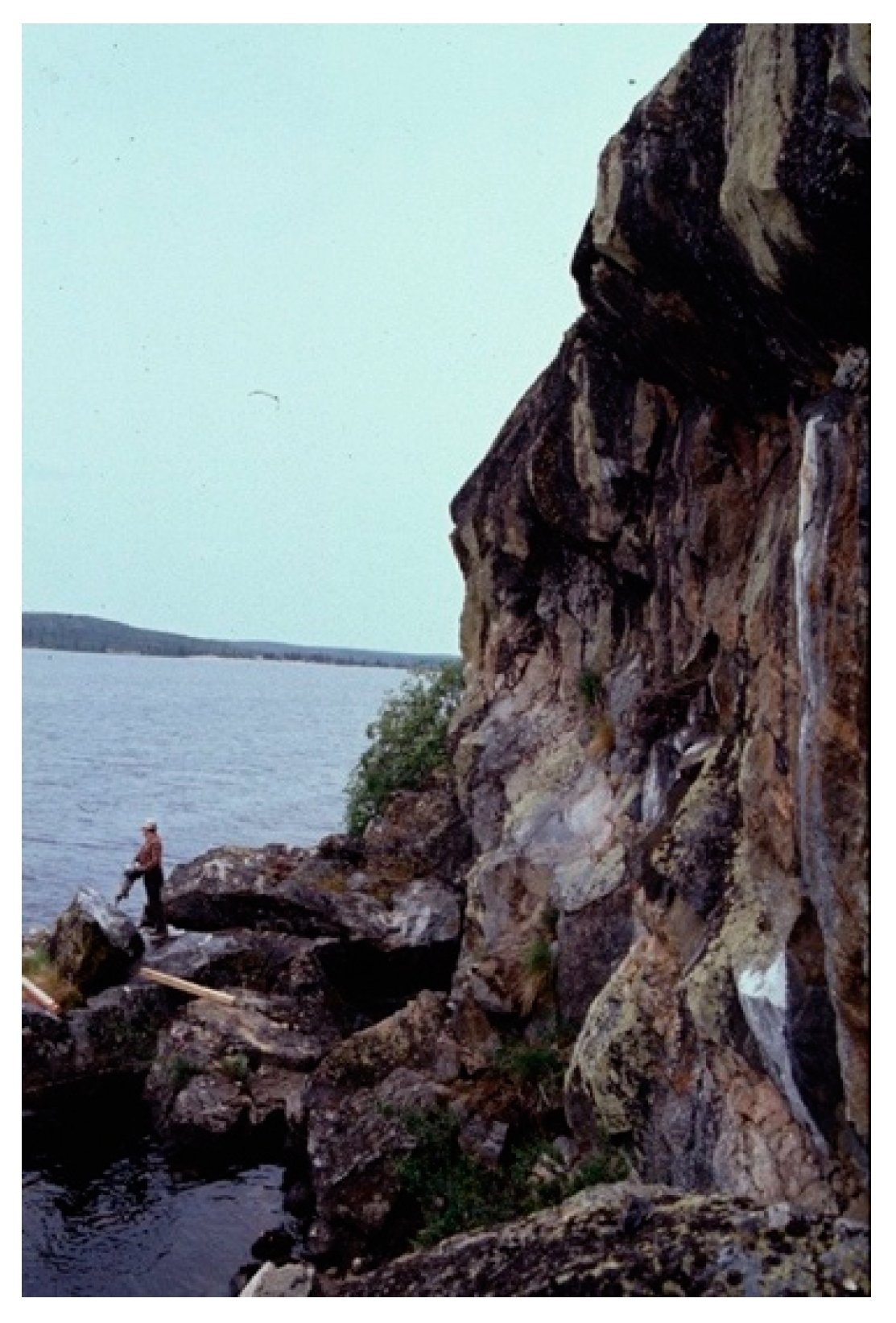
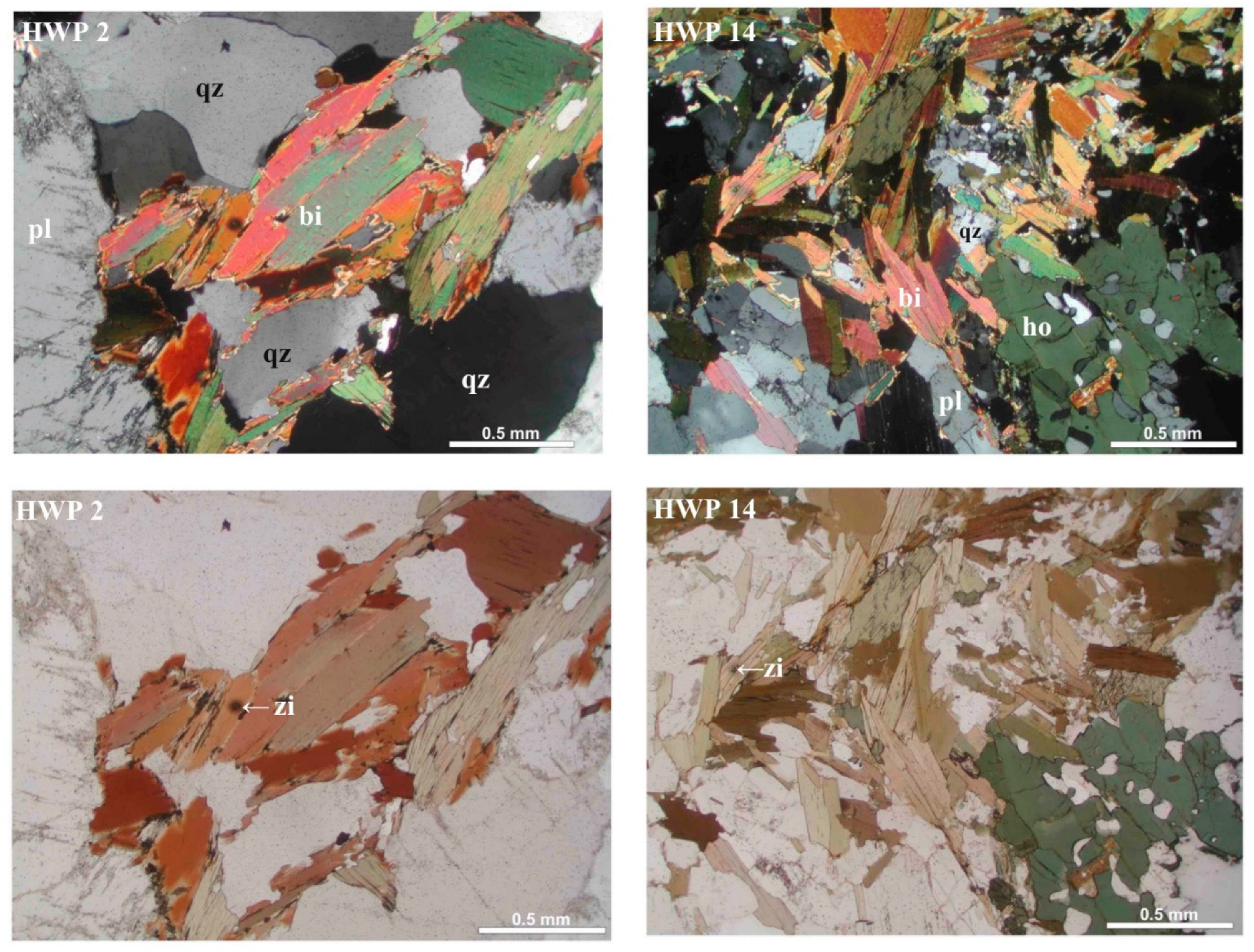





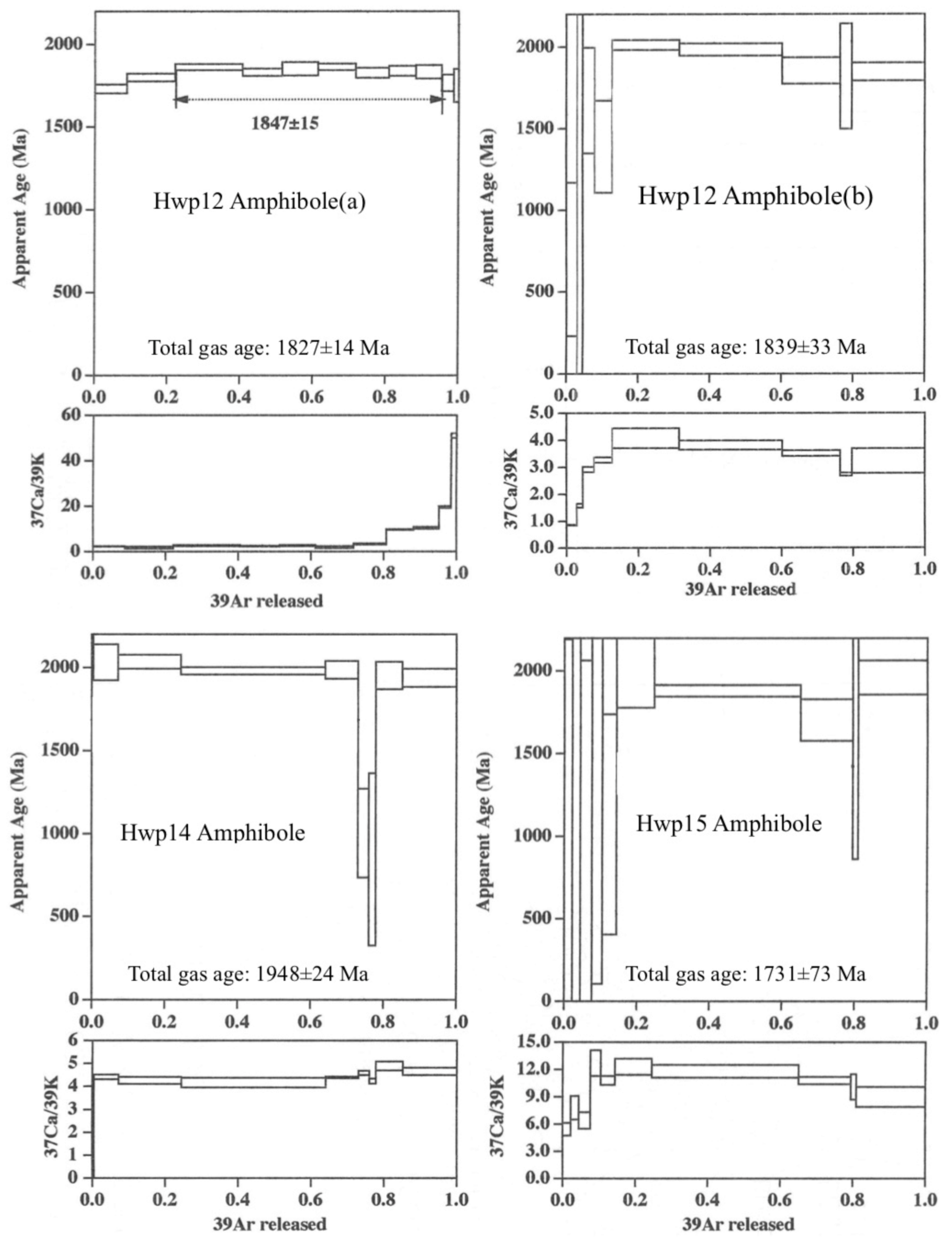

| Sample | Potassium | Rad. 40Ar | Age | Non-Rad. Ar | Distance | Rock Type | Long. | Lat. |
|---|---|---|---|---|---|---|---|---|
| (wt.%) | (10−4 cc STP/g) | (Ma) | (%) | (km) | ||||
| Biotite | ||||||||
| Hwp 1 | 7.332 | 8.946 | 1810 ± 26 | 0.2 | 0.0 | felsic | 115°54′16.02″ W | 65°14′27.19″ N |
| 9.259 | 1821 ± 26 | 0.3 | 0.0 | ′ | ||||
| Weighted average | 1816 ± 18 | |||||||
| Hwp 2 | 6.461 | 7.995 | 1837 ± 26 | 0.4 | 0.6 | felsic | 115°53′46.11″ W | 65°14′7.40″ N |
| Hwp 3 | 7.755 | 9.559 | 1832 ± 26 | 0.5 | 0.7 | felsic | 115°53′21.81″ W | 65°14′23.83″ N |
| Hwp 4 | 7.769 | 9.757 | 1854 ± 26 | 0.4 | 1.7 | Int. | 115°52′6.45″ W | 65°14′15.97″ N |
| Hwp 9 | 7.122 | 9.185 | 1884 ± 26 | 0.3 | 4.1 | felsic | 115°50′22.68″ W | 65°13′31.01″ N |
| 8.856 | 1842 ± 26 | 0.3 | 4.1 | |||||
| Weighted average | 1863 ± 18 | |||||||
| Hwp 11 | 7.462 | 9.562 | 1877 ± 26 | 0.4 | 5.9 | Int. | 115°47′28.12″ W | 65°13′3.37″ N |
| Hwp 12 | 7.217 | 8.642 | 1799 ± 25 | 0.3 | 7.0 | felsic | 115°46′12.91″ W | 65°12′51.39″ N |
| Hwp 13 | 7.935 | 9.535 | 1803 ± 26 | 0.4 | 7.0 | felsic | 115°46′12.91″ W | 65°12′51.39″ N |
| Hwp 14 | 7.227 | 8.615 | 1794 ± 25 | 0.5 | 8.3 | felsic | 115°44′34.80″ W | 65°12′31.59″ N |
| 8.773 | 1814 ± 26 | 0.3 | 8.3 | |||||
| Weighted average | 1804 ± 18 | |||||||
| Hwp 17 | 7.562 | 9.329 | 1833 ± 26 | 0.3 | 14.5 | Int. | 115°37′1.12″ W | 65°11′31.66″ N |
| Hwp 18 | 6.987 | 8.518 | 1819 ± 26 | 0.2 | 15.0 | Int. | 115°36′49.07″ W | 65°10′53.86″ N |
| Hwp 19 | 7.142 | 8.547 | 1789 ± 26 | 0.2 | 15.0 | felsic | 115°35′39.35″ W | 65°11′46.60″ N |
| Hwp 20 | 6.680 | 7.397 | 1711 ± 25 | 0.1 | 15.4 | mafic | 115°37′34.09″ W | 65°10′5.66″ N |
| Hwp 21 | 6.521 | 7.889 | 1811 ± 26 | 0.2 | 16.6 | felsic | 115°35′31.20″ W | 65° 9′31.14″ N |
| Hwp 22 | 7.103 | 8.711 | 1826 ± 26 | 0.2 | 16.6 | felsic | 115°35′31.20″ W | 65° 9′31.14″ N |
| Hwp 23 | 5.532 | 6.745 | 1819 ± 26 | 0.1 | 17.9 | mafic | 115°33′37.14″ W | 65°10′4.40″ N |
| Hwp 24A | 6.472 | 7.751 | 1798 ± 25 | 0.2 | 17.9 | mafic | 115°33′37.14″ W | 65°10′4.40″ N |
| Hwp 26 | 7.877 | 9.854 | 1789 ± 25 | 0.1 | 17.9 | Int. | 115°33′35.75″ W | 65° 9′54.76″ N |
| Hwp 27 | 6.907 | 8.129 | 1779 ± 25 | 0.2 | 17.9 | mafic | 115°33′35.75″ W | 65° 9′54.76″ N |
| Amphibole | ||||||||
| Hwp 5 | 0.627 | 0.768 | 1824 ± 26 | 0.9 | 2.3 | mafic | 115°51′25.82″ W | 65°14′2.59″ N |
| Hwp 6 | 0.274 | 0.296 | 1685 ± 25 | 2.3 | 2.9 | mafic | 115°50′54.73″ W | 65°13′43.43″ N |
| Hwp 8 | 1.114 | 1.383 | 1840 ± 26 | 0.5 | 3.4 | Int. | 115°50′22.68″ W | 65°13′31.01″ N |
| Hwp 9 | 0.952 | 1.200 | 1858 ± 26 | 0.5 | 4.1 | felsic | 115°50′22.68″ W | 65°13′31.01″ N |
| Hwp 10A | 0.948 | 1.201 | 1863 ± 26 | 0.4 | 5.1 | Int. | 115°48′22.87″ W | 65°13′16.16″ N |
| Hwp 11 | 1.178 | 1.608 | 1952 ± 27 | 0.5 | 5.9 | Int. | 115°47′28.12″ W | 65°13′3.37″ N |
| 1.599 | 1945 ± 27 | 0.4 | 5.9 | 115°47′28.12″ W | 65°13′3.37″ N | |||
| Weighted average | 1949 ± 19 | |||||||
| Hwp 12 | 1.262 | 1.647 | 1899 ± 26 | 0.4 | 7.0 | felsic | 115°46′12.91″ W | 65°12′51.39″ N |
| Hwp 14 | 1.269 | 1.705 | 1933 ± 27 | 0.4 | 8.3 | felsic | 115°44′34.80″ W | 65°12′31.59″ N |
| 1.676 | 1913 ± 26 | 0.3 | 8.3 | 115°44′34.80″ W | 65°12′31.59″ N | |||
| Weighted average | 1923 ± 19 | |||||||
| Hwp 15 | 0.482 | 0.556 | 1756 ± 25 | 0.5 | 10.9 | Int. | 115°41′9.07″ W | 65°12′17.52″ N |
| 0.537 | 1718 ± 25 | 0.3 | 10.9 | 115°41′9.07″ W | 65°12′17.52″ N | |||
| Weighted average | 1737 ± 18 | |||||||
| Hwp 16 | 0.833 | 1.056 | 1864 ± 26 | 0.7 | 12.9 | mafic | 115°38′33.82″ W | 65°11′59.46″ N |
| Hwp 18 | 1.947 | 2.309 | 1788 ± 26 | 0.3 | 15.0 | Int. | 115°36′49.07″ W | 65°10′53.86″ N |
| Hwp 25B | 0.420 | 0.476 | 1737 ± 27 | 0.4 | 17.9 | felsic | 115°33′37.14″ W | 65°10′4.40″ N |
| Sample | Mineral | K-Ar Age | 40Ar/39Ar | 40Ar/39Ar |
|---|---|---|---|---|
| Ma | Total gas age (Ma) | Plateau age (Ma) | ||
| Hwp 1 | biotite | 1816 ± 18 | 1820 ± 21 | 1826 ± 21 |
| Hwp 2 | biotite | 1837 ± 26 | 1885 ± 13 | 1886 ± 13 |
| Hwp 3 | biotite | 1832 ± 26 | ||
| Hwp 4 | biotite | 1854 ± 26 | 1866 ± 18 | 1870 ± 18 |
| Hwp 5 | amphibole | 1824 ± 26 | 1789 ± 23 | 1814 ± 22 |
| Hwp 6 | amphibole | 1685 ± 25 | ||
| Hwp 8 | amphibole | 1840 ± 26 | ||
| Hwp 9 | biotite | 1863 ± 18 | ||
| amphibole | 1858 ± 26 | 1648 ± 45 | ||
| Hwp 10A | amphibole | 1863 ± 26 | 1580 ± 68 | |
| Hwp 11 | biotite | 1877 ± 26 | 1709 ± 49 | |
| amphibole | 1949 ± 19 | 1598 ± 126 | ||
| Hwp 12 | biotite | 1799 ± 25 | 1994 ± 9 | |
| amphibole | 1899 ± 26 | (a) 1827 ± 14 | (a) 1847 ± 15 | |
| (b) 1839 ± 33 | ||||
| Hwp 13 | biotite | 1803 ± 26 | ||
| Hwp 14 | biotite | 1804 ± 18 | 1817 ± 8 | 1877 ± 8 |
| amphibole | 1923 ± 19 | 1948 ± 24 | ||
| Hwp 15 | amphibole | 1737 ± 18 | 1731 ± 73 | |
| Hwp 16 | amphibole | 1864 ± 26 | 1683 ± 66 | |
| Hwp 17 | biotite | 1833 ± 26 | ||
| Hwp 18 | biotite | 1819 ± 26 | 1907 ± 12 | 1935 ± 14 |
| amphibole | 1788 ± 26 | 2127 ± 10 | ||
| Hwp 19 | biotite | 1789 ± 26 | ||
| Hwp 20 | biotite | 1711 ± 25 | ||
| Hwp 21 | biotite | 1811 ± 26 | ||
| Hwp 22 | biotite | 1826 ± 26 | ||
| Hwp 23 | biotite | 1819 ± 26 | ||
| Hwp 24A | biotite | 1798 ± 25 | ||
| Hwp 25B | biotite | 1939 ± 8 | 1951 ± 11 | |
| amphibole | 1737 ± 27 | 1967 ± 11 | 1964 ± 12 | |
| Hwp 26 | biotite | 1789 ± 25 | ||
| Hwp 27 | biotite | 1779 ± 25 |
Disclaimer/Publisher’s Note: The statements, opinions and data contained in all publications are solely those of the individual author(s) and contributor(s) and not of MDPI and/or the editor(s). MDPI and/or the editor(s) disclaim responsibility for any injury to people or property resulting from any ideas, methods, instructions or products referred to in the content. |
© 2024 by the authors. Licensee MDPI, Basel, Switzerland. This article is an open access article distributed under the terms and conditions of the Creative Commons Attribution (CC BY) license (https://creativecommons.org/licenses/by/4.0/).
Share and Cite
Sato, M.; Hyodo, H.; Sugiura, K.; Tsujimori, T.; Itaya, T. Regional-Scale Paleoproterozoic Heating Event on Archean Acasta Gneisses in Slave Province, Canada: Insights from K–Ar and 40Ar/39Ar Chronology. Minerals 2024, 14, 397. https://doi.org/10.3390/min14040397
Sato M, Hyodo H, Sugiura K, Tsujimori T, Itaya T. Regional-Scale Paleoproterozoic Heating Event on Archean Acasta Gneisses in Slave Province, Canada: Insights from K–Ar and 40Ar/39Ar Chronology. Minerals. 2024; 14(4):397. https://doi.org/10.3390/min14040397
Chicago/Turabian StyleSato, Megumi, Hironobu Hyodo, Kei Sugiura, Tatsuki Tsujimori, and Tetsumaru Itaya. 2024. "Regional-Scale Paleoproterozoic Heating Event on Archean Acasta Gneisses in Slave Province, Canada: Insights from K–Ar and 40Ar/39Ar Chronology" Minerals 14, no. 4: 397. https://doi.org/10.3390/min14040397







